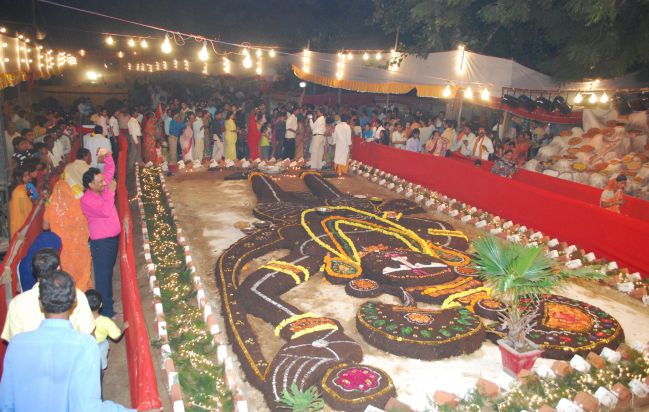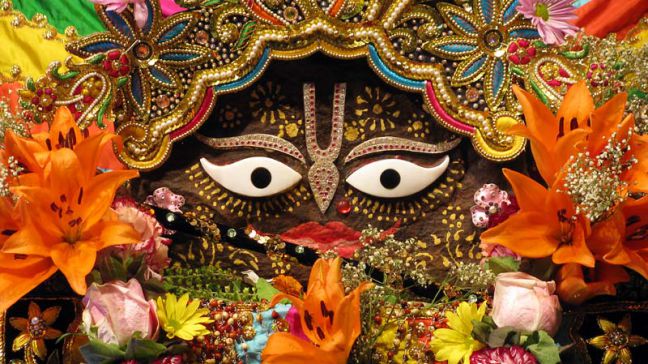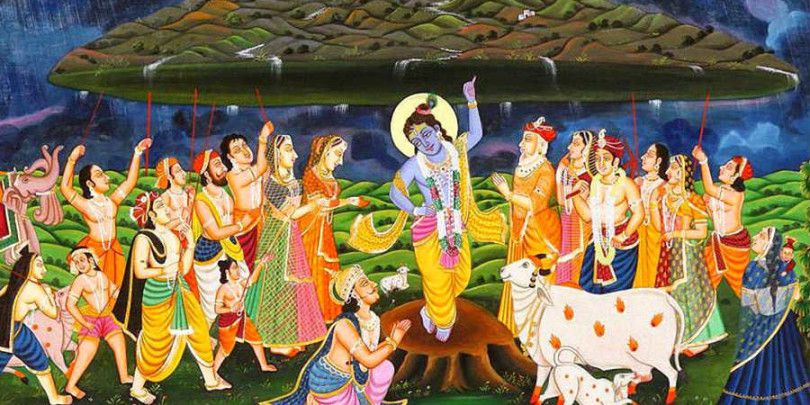Govardhan Puja (Annakut Puja) or Bali Pratipada is held a day after the main Diwali in the month of Kartik. The day is celebrated by the Hindus as Lord Krishna had defeated the God Indra. Sometimes there might be one day gap between Diwali and Govardhan Puja. People celebrate Govardhan Puja by making food of cereals such as wheat, rice, curry of gram flour and leafy vegetables in order to offer to the Hindu Lord Krishna.
Govardhan Puja 2021
Govardhan Puja on Friday, November 5, 2021
Govardhan Puja Pratahkal Muhurat = 06:36 AM to 08:47 AM
Duration = 02 Hours 11 Mins
Govardhan Puja Sayankal Muhurat = 15:27 to 17:42
Duration = 2 Hours 14 Mins
Pratipada Tithi Begins = 02:44 AM on Nov 05, 2021
Pratipada Tithi Ends = 11:14 PM on Nov 05, 2021
Why is Govardhan Puja Celebrated?
At some places in India such as the Maharashtra it is celebrated as the Bali Pratipada or Bali Padva. It is celebrated in regards of the victory of Vamana (incarnation of the Lord Vishnu) over demon King Bali. It is considered that King Bali was booned by the Lord Vamana to be very powerful.
Somewhere this day is celebrated as the New Year day by Gujarati in the Shukla Paksha Pratipada of the month of Kartik.
Legends of Govardhan Puja
Govardhan puja is celebrated to commemorate the history of Govardhan Parbat through which the lives of many people was saved from the critical rain. It is considered that the people of Gokul were used of worshipping God Indra, also known as God of rain. But Lord Krishna had to change such type of opinions of the people of Gokul. He told that you should all worship the Annakut hill or Govardhan Parbat as he is the real God who is nurturing and saving your lives from drastic conditions by giving you food and shelter.
Hence, they had started worshipping that mountain in the place of God Indra. By seeing this, Indra became angry and started raining too much in the Gokul. Finally Lord Krishna had saved their lives by lifting the Govardhan hill at his little finger and covered the people of Gokul under it. In this way proud Indra had defeated by the Lord Krishna. Now, the day is celebrated as Govardhan Puja to offer the homage to the Govardhan Parbat. Govardhan puja festival is also being celebrated as the Annakut.
The day is also celebrated as Padva or Bali Pratipada in the Maharashtra as it is considered that demon King Bali was defeated and pushed to Patal Loka by the Lord Vishnu in the form of Vamana (incarnation of Lord Vishnu).
How to celebrate Annakut or Govardhan Puja

People of Gokul and Mathura celebrate this festival with great enthusiasm and pleasure. People make round, also known as Parikrama (which starts from the bath in the Manasi Ganga and puja of Manasi Devi, Harideva and Brahma Kunda. There are approximately eleven Silas on the way of Govardhana Parikrama which have their own special significance) of the Govardhan hill and offer Puja.
People make a form of Govardhan Dhari Ji through the heap of cow dung, mountain of food and adorn it with the flowers and worship. The mean of Annakut is, people make variety of Bhog to present to the Lord Krishna. Idols of the God are bathed in the milk and clothed with new clothes as well as jewelry. Then the worship is performed through the traditional prayers, Bhog and Aarti.
It is celebrated all over the India by decorating the temples of Lord Krishna and organizing a lot of events and after puja foods are distributed among the people. People get blessings of the Lord Krishna by having Prasad and touching their head to the feet of God.
Significance of Govardhan Puja
People offer puja to the Govardhan Mountain by preparing Annakut (various types of food) and through the singing and dancing. They consider that the mountain is the real God of them a he provides the way to live life, provides shelter in severe conditions and save their life. There are various customs and traditions of celebrating Govardhan puja every year with the great pleasure. People worship Lord Krishna at this special day to commemorate the victory of God over the evil power. People worship Govardhan Mountain in the belief that they would be protected by this mountain ever and they would always get the source of living.
People offer bath to their cow and bulls in the morning and decorate with the saffron and garlands etc. They make cow dung heap and worship by offering Kheer, Batashe, garland, sweet and delicious foods with immense enthusiasm. They prepare Naivedya of the Chappan Bhog (means 56 food items) or 108 food items in order to offer to lord during puja.
Govardhana Parbat is just like peacock shape which can be described as; Radha Kunda and Syama Kunda makes the eyes, Dan Ghati makes the neck, Mukharavinda makes the mouth and Punchari makes back as well as tail feathers. It is considered that the height of this mountain is decreasing day by day (a seed of mustard daily) because of the curse of Pulastya Muni.
Once, in the Satya Yuga, the Pulastya Muni went to the Dronacala (the king of mountains) and requested for his son named Govardhana. The king was very depressed and appealed the Muni that he cannot bear the disconnection from his son. Finally his son was sent with Muni under the circumstances that if he would put down, he would stay there.
On the way the Muni had put him down while passing through the Braja Mandala in order to reply the nature’s call. After coming back he found he cannot move the Govardhana from that place. Then he got angry and cursed the Govardhana to get reduce in size slowly. It was around 64 miles long and 40 miles wide, 16 miles high and now remains only of 80 ft.
Govardhan Parikrama

Govardhana Hill has a Parikrama of about fourteen miles (23 km.) and can take five to six hours to complete if one walks at a brisk pace. People from all over India visit Vraja in order to perform Govardhana Parikrama. On auspicious occasions like Guru Purnima, Purusottamamasa or Govardhana-puja, over half a million people go around the sacred hill.
There is no time limit for performing Govardhana Parikrama, for those who perform the dandavata Parikrama it may take weeks and sometimes even months to complete. The dandavata Parikrama is performed by standing in one spot, offering obeisance like a stick (danda) by lying flat on the ground. One then places a stone where the fingertips touch the ground in order to mark the spot. Standing up, one moves to the stone marker and again offers obeisance’s like A group of ladies performing Parikrama a stick, again marking the spot where the fingertips touch the ground, thus repeating the same process again and again all the way around Govardhana Hill. Some sadhus perform 108 dandavata Parikrama by offering 108 obeisance in one spot before moving to the next. This can take a number of months to complete and one has to sleep wherever one is and accept alms from pilgrims passing by.
The six Gosvamis of Vrindavan regularly performed Parikrama of Govardhana Hill, especially Sanatana GosvamI and Raghunatha dasa GosvamI who, while staying near Govardhana, would perform Parikrama every day. Sanatana GosvamI used to perform a much longer Parikrama covering a distance of twenty four miles and including such places as Candrasarovara, Syama Dhak, Ganthuli-grama, Surya-kunda, Mukharai and Kilola-kunda.
Other great personalities who performed Govardhana Parikrama were Madhavendra Purl, Advaita Acharya, Lord Nityananda, VallabhAcharya, Narottama dasa Thakura, Srinivasa Acharya, Raghava Gosvami, Visvanatha Chakravarti and of course Lord Caitanya Mahaprabhu who, upon seeing Govardhana Hill for the first time, fell down like a stick and began embracing one of the rocks. On touching the rock from Govardhana the Lord began to shed tears of love and almost became mad due to transcendental ecstasy.
This ritual of Parikrama is considered to be even better if is it done with milk. A clay pot filled with milk, with a hole at the bottom, is carried by the devotees in one hand and a pot filled with dhoop (incense smoke) in another. An escort continuously fills up the pot with milk till the Parikrama is completed. Parikrama is also done with candy being handed out to children, en-route.[16] Parikrama of Govardhana hill starts at the Manasi-Ganga Kund (lake) and then after having darsan of Lord Harideva, from Radha-kunda village, where the Vrindavan road meets the Parikrama path. After Parikrama of 21 kilometers, covering important tanks, shilas and shrines such as Radha Kunda, Syama Kunda, Dan Ghati, Mukharavinda, Rinamochana Kunda, Kusuma Sarovara and Punchari, it ends at Mansi Ganga Kund only.






